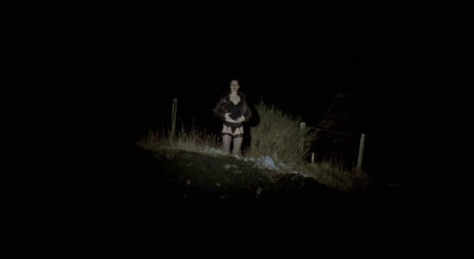 Early in Lynne Ramsey’s film Morvern Callar (2002), after the titular character, Morvern, has decided to ignore her boyfriend’s suicide and go out to a house party with her friend, she escapes the party and goes out to the water. Standing there alone in the dark she is caught in the lights of a passing boat. The lights flick on to her and then off, then back as though surprised to see a person on the cold shore and once the light settles on her, once she commands its attention, she slowly lifts her skirt, and stands unmoving, staring out at us.
Early in Lynne Ramsey’s film Morvern Callar (2002), after the titular character, Morvern, has decided to ignore her boyfriend’s suicide and go out to a house party with her friend, she escapes the party and goes out to the water. Standing there alone in the dark she is caught in the lights of a passing boat. The lights flick on to her and then off, then back as though surprised to see a person on the cold shore and once the light settles on her, once she commands its attention, she slowly lifts her skirt, and stands unmoving, staring out at us.
Ramsey frames this as a long shot which leaves the detail of Morvern’s body unclear. She appears less a body then a blur of black and white. As Mulvey notes in her analysis of Sternberg’s films, “The beauty of the woman as object and the screen space coalesce; she is…a perfect product whose body, stylized and fragmented through close up is the content of the film and the direct recipient of the spectator’s gaze”(Mulvey 65) and so the long shot disrupts the fetishistic idolizing of the female refusing to assuage the castration anxiety of the male spectator and establishes a relationship other than object to Morvern.
In Lorraine Leu’s analysis of Madame Sata she notes that “The film oscillates between the racialized gaze to which João is subjected and the defiant “oppositional gaze” (hooks 2003) he directs back as he generates his own representations” (Leu 81). As in Madame Sata, Morvern looks back and resists the gaze and then moves beyond mere resistance to directly confront the erotic scopophilia of the gaze by lifting her skirts, as though to say, “Is this what you came for?”. And it is this kind of resistance that is evident throughout the film and exemplifies the “feminist filmmaking practice” (hooks 262) that hooks via Doane describes.
Mulvey, Laura Mulvey, Laura; Visual Pleasure and Narrative Cinema (1975). Screen Volume, Issue 16, 6-18.
Leu, Lorraine; Performing Race and Gender in Brazil: Karim Ainouz’s Madame Satã (2002). Race/Ethnicity: Multidisciplinary Global Contexts, Volume 4, Number 1, Autumn 2010, 83
hooks, Bell. “The Oppositional Gaze: Black Female Spectators.” Movies and Mass Culture:, 1996, pp. 247-269.
